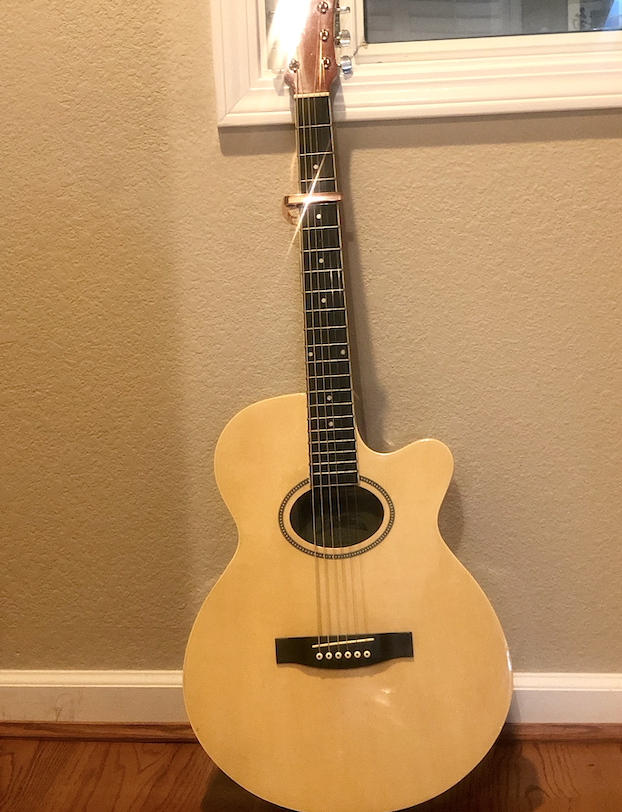I’ve always loved listening to sad songs that lament a singer’s worst heartbreak accompanied by a guitar. For years, I watched those artists perform and fantasized about being a skilled guitarist one day as well.
My mom, a non-guitar player, told me that the guitar should be one of the easiest instruments to learn. With all the extra time that quarantine had given me, I decided to start learning it, thinking it would be easy. Soon, I found out that I was as naive as could be.
Don’t be fooled by the country singers who strum chords with ease — in truth, playing the guitar is much more painful than it looks.
I have a beige-colored acoustic guitar that my grandparents gifted to my older sister when she was in fourth grade. She never touched it, so naturally, I claimed it as my own.
After I tuned the guitar, I followed an instructional video on YouTube to learn the famous Chinese pop song, “A Little Happiness (小幸运).”
The first step to playing was to put my left-hand middle finger on the third fret of the fifth string. Despite this chord being one of the simpler ones, I still felt like there were a million tiny needles piercing my middle finger from the friction. The hardness of the metal strings doubled my agony.
I managed to persevere through half of the tutorial before hitting the first major roadblock of my guitar career: the barre chord, which requires the player to press down on all six strings across the same fret with only one finger.
I attempted to play that chord twice. The first time, the first and fourth strings were silent due to my lack of strength; the second time, only two strings even made a sound.
By the end of my short-lived practice section, my fingers were sore and tired, and the skin under my nails was numb from pressing down on the metal string. That was enough for day one.
Before I even started day two, I noticed a stabbing pain in my fingers on my left hand. I decided to take a break from playing and resume when my hand felt better.
Then I neglected my guitar for two weeks. Concerned about the subpar speed at which I was learning the instrument, I decided to approach a teacher that my mom found on WeChat.
With a teacher, I was able to learn to play the guitar with a more structured curriculum. My teacher also acted as a source of motivation for me to practice harder.
My first assignment was to play major and chromatic scales to practice my finger strength. However, the soreness from my fingers hindered my progress. I couldn’t practice the guitar for longer than 15 minutes per day. For the first two weeks of class, I could detect a hint (OK fine, a lot) of frustration from my teacher whenever I attempted to play those scales.
Luckily, in a few weeks’ time, my first layer of calluses thickened on my left hand, which acted as a barrier between my skin and the strings. The calluses allowed me to practice guitar for hours, and finally, I learned to play those scales slowly but smoothly.
Then I hit the second major roadblock of my guitar career: changing strings.
I was tuning the G-string, the fourth string in the guitar, when an unfortunate event happened — the string snapped in the middle and flicked onto the table. I should have known that it was going to break sooner or later, given that the strings were almost seven years old.
I ordered a new set of strings off Amazon immediately. Once they arrived, my dad and I partnered up and decided to restring the whole guitar because of its oxidation.
Our first attempt resulted in utter failure — we didn’t leave enough length on the string to twist around the pegs completely. Our second attempt resulted in a catastrophe as well. While we left enough space for the string, we twisted it the wrong way. Being absolute perfectionists, we restarted.
Third time’s the charm. I carefully gauged the length of the string and my dad viewed numerous YouTube videos to determine the correct direction of the strings. Finally, we successfully restringed the whole guitar.
I’ve been learning the guitar for almost five months now. Despite all the pain, I started to appreciate the instrument more and experiment with different sounds and chords (with the exception of that irksome barre chord). Although my skills won’t have me performing alongside Taylor Swift any time soon, at least I am one step close to achieving my dreams of strumming the guitar while singing sad songs.


























